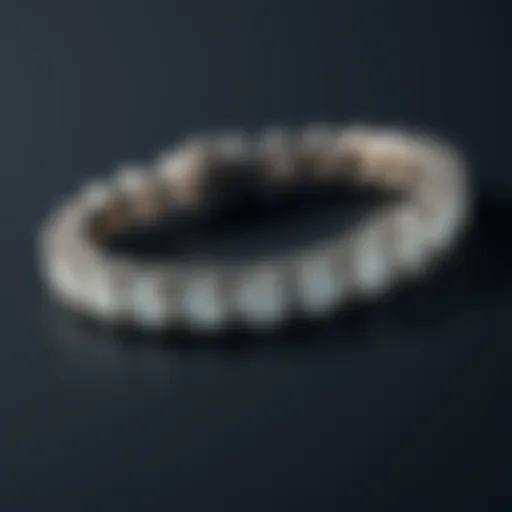Understanding the Pricing of 5.8 Carat Diamonds
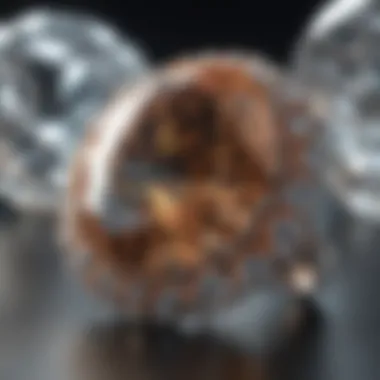

Intro
The world of diamonds is intricate, especially when it comes to pricing a 5.8 carat diamond. Understanding the various factors influencing its price is essential for anyone involved in the jewelry industry or consumers looking to invest. This section provides a foundation for comprehending the nuances that affect diamond valuation.
Gemstone Overview
Definition and Characteristics
Diamonds are precious gemstones, renowned for their remarkable hardness and optical qualities. They are composed of carbon atoms arranged in a crystal lattice structure, making them one of the hardest natural substances known to man. A diamond's brilliance stems from its unique ability to refract light.
Classification of Gemstones
Diamonds fall into a broader category of gemstones, which can be classified based on their origin, quality, and rarity. Natural diamonds are formed under high-pressure and high-temperature conditions in the Earth’s mantle, while synthetic diamonds are created artificially in labs. Considerations such as color, clarity, cut, and carat weight are crucial in classifying diamonds and determining their value.
Properties of Gemstones
Physical Properties
The physical properties of diamonds, which include their hardness, density, and thermal conductivity, significantly influence their desirability. Diamonds score a 10 on the Mohs scale of hardness, making them suitable for various applications, from jewelry to industrial uses. Their high density can also mean that a larger diamond, such as a 5.8 carat one, will be visually striking.
Chemical Properties
From a chemical perspective, diamonds are purely carbon. However, the presence of trace elements can affect their color. For instance, nitrogen in the crystal structure can impart a yellow hue, while boron can lend a blue tint. Understanding these properties is essential when discussing the pricing of diamonds, as color can greatly affect market value.
"Knowing the intrinsic properties of diamonds is vital. It influences both their emotional and monetary value."
In summary, an understanding of the gemstone's definition, classification, and properties lays the groundwork for a more detailed discussion on the pricing factors for a 5.8 carat diamond. The subsequent sections will delve into the specifics of carat weight, grading, market trends, and ethical sourcing, providing a holistic view of diamond valuation.
Prologue to Diamond Pricing
Understanding how diamonds are priced is crucial for anyone involved in the gemstone market. This includes purchasers, collectors, and sellers of diamonds. Each gemstone holds value, yet diamonds are often considered the most significant due to their combination of rarity, beauty, and durability. Diamond pricing is not arbitrary. It is influenced by various factors that work together to form a diamond's overall value. This article aims to illuminate these factors, particularly focusing on the pricing of 5.8 carat diamonds.
The Importance of Carat Weight
Carat weight is one of the primary factors in determining the price of a diamond. The weight of diamonds affects their cost on a logarithmic scale. It means that as carat weight increases, the price does not increase linearly; it escalates more steeply with higher carats. A 5.8 carat diamond is heavier than a typical engagement ring diamond, which often weighs between one to two carats. The perception of size, paired with carat weight, enhances its value.
Consumer demand plays a role here. Larger diamonds are generally perceived as more valuable. This perception can lead to higher prices, particularly for stones that are well-cut and possess desirable characteristics.
Market Demand and Pricing Trends
Market demand significantly influences pricing for diamonds of all carat weights, including 5.8 carats. Economic conditions, fashion trends, and shifts in consumer preferences can all create fluctuations in demand.
In the last decade, demand for larger diamonds has grown, making prices for them rise steadily. The merger of online marketplaces with traditional jewelers has altered how diamonds are priced and sold.
"The luxury market is sensitive to trends and shifts in buying behavior, with larger diamonds growing in popularity, particularly among younger buyers."
Current trends indicate that diamonds are not just bought for adornment; they are viewed as status symbols and investments. This shift often drives prices upward, particularly for high-quality 5.8 carat diamonds.
Ultimately, understanding the interplay between carat weight and market trends allows potential buyers and investors to make informed decisions in the diamond marketplace.
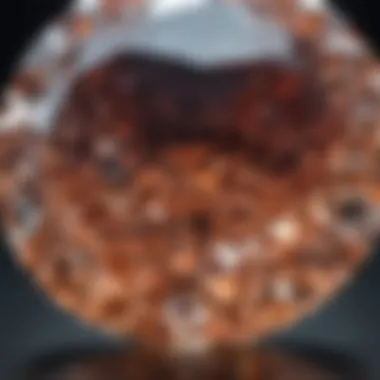

Factors Influencing the Price of 5. Carat Diamonds
Understanding the factors influencing the price of 5.8 carat diamonds is crucial for consumers and collectors alike. Several elements contribute to the value of these gemstones, including the quality assessments based on the 4Cs, market trends, and external economic fluctuations. Recognizing these factors helps buyers make informed decisions, ensuring they pay a fair price for their diamond. Additionally, it assists sellers in pricing their products effectively, appealing to a discerning market.
Quality Assessment via the 4Cs
Cut
Cut is a vital element in determining a diamond's beauty and brilliance. It refers to how well the diamond has been shaped and faceted. A well-cut diamond reflects light more efficiently, enhancing its sparkle. In this article, we emphasize the importance of cut because it directly impacts how a 5.8 carat diamond is perceived visually. A diamond with an excellent cut can command a higher price compared to a poorly cut one of the same carat weight. The precise angles and proportions of a cut can also affect durability, making this consideration crucial for long-term value.
Color
Color grading in diamonds ranges from completely colorless to light yellow, with colorless diamonds being most sought after. The color has a direct correlation with pricing, especially for larger stones like 5.8 carats. The reasoning behind the value of color lies in rarity. A lower color grade can diminish the overall appearance of a diamond, hence reducing its value. The unique feature of diamonds in the colorless range is their ability to display brilliance more effectively, making them a popular choice for buyers who prioritize aesthetics.
Clarity
Clarity refers to the presence of internal or external flaws in a diamond, known as inclusions and blemishes. Diamonds with higher clarity are rarer and typically more valuable. This factor has significant implications for a 5.8 carat diamond's price, as even minor imperfections can detract from its perceived value. Highlighting clarity stations the diamond's quality and overall appeal. Hence, a clear diamond, free from visible flaws, often results in higher demand and consequently a higher price point.
Carat Weight
Carat weight is perhaps the most straightforward consideration when evaluating diamond pricing. In general, larger diamonds, such as those around 5.8 carats, are more precious and rarer. As carat weight increases, the price per carat tends to rise disproportionately. This effect is due to increased demand for larger stones and the diminishing availability as size increases. Consequently, the carat weight significantly affects pricing, indicating both the dignity and value of the diamond.
Market Fluctuations
The diamond market is susceptible to various fluctuations influenced by economic conditions, fashion trends, and consumer demand. Price variations can be caused by changes in raw material costs, affecting the diamond's final price. For instance, a sudden increase in demand for luxury goods may raise diamond prices, including the 5.8 carat variety. Additionally, economic downturns can similarly affect prices negatively as buyers become more cautious. It is critical to stay informed about these fluctuations for anyone involved in the diamond market, whether as a buyer or seller.
Diamond Grading Standards
Diamond grading standards play a crucial role in determining the price and overall value of a 5.8 carat diamond. These standards help establish a consistent and transparent framework for evaluating diamonds, allowing consumers to make informed purchasing decisions. Understanding grade criteria is not just important for buyers; it also benefits gem dealers and appraisers.
The grading process assesses various characteristics of diamonds, primarily using the 4Cs: cut, color, clarity, and carat weight. These factors can significantly influence the market perception of a diamond, and therefore, its price. Without a clear understanding of these grading standards, buyers may overlook essential qualities that contribute to a diamond's value, or they may overpay for a stone that does not meet their expectations.
Understanding Certification Bodies
There are several certification bodies that evaluate diamond quality. Among these, the Gemological Institute of America (GIA), American Gem Society (AGS), and European Gemological Laboratory (EGL) are the most recognized. Each organization has its unique processes and standards that influence the perceived value of diamonds.
GIA
The GIA is widely regarded as a leading authority in gemological education and grading. Its reports are known for their accuracy and detail, providing comprehensive data on a diamond's characteristics. One key characteristic of GIA is its strict grading standards, which help maintain consistency and credibility across the diamond market. Since GIA reports are respected globally, having a GIA certification may enhance a diamond's resale potential.
However, GIA grading can be rigid, sometimes leading to discrepancies in perceived value when compared to other certifications. Buyers should understand that, while GIA standards are stringent, they may not always align with market preferences in certain regions.
AGS
AGS is another reputable certifying body, offering high standards in diamond grading but with a slightly different approach. One key feature of AGS is its focus on performance-based grading, particularly in the 'Cut' category. This method can give buyers a better understanding of how a diamond will appear in real-world use, which is beneficial for those prioritizing aesthetics over theoretical standards.
However, AGS reports may contain less detail in other categories like color and clarity, which can frustrate some purchasers. Therefore, while AGS certification is often seen as beneficial, some buyers may prefer the more comprehensive reports provided by GIA.
EGL
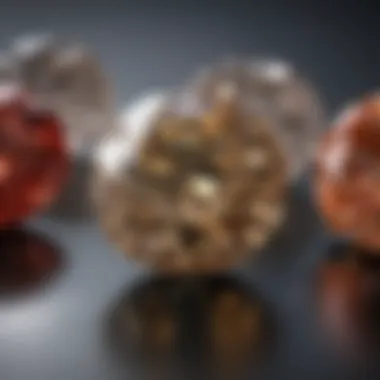

EGL has gained attention for its accessibility and for grading diamonds at more lenient standards compared to GIA and AGS. One characteristic that makes EGL popular is its pricing; diamonds graded by EGL may often come at a lower initial price point. This can be appealing for those looking for a cost-effective option. However, buyers should be cautious. EGL's lower grading standards may result in diamonds that do not hold their value as well as those graded by GIA or AGS.
As such, potential buyers need to carefully consider what certification body they trust when evaluating a 5.8 carat diamond. A diamond with EGL certification may present a great bargain, but its long-term value could be in question, making it necessary to evaluate their investment effectively.
The Impact of Certification on Value
Certification plays a significant role in the valuation of diamonds. A certified diamond typically commands a higher price because certification provides a guarantee of quality and authenticity. Buyers can determine that a diamond is not only genuine but also understand its grading based on the 4Cs.
Certification can dramatically affect resale value. Diamonds with GIA certifications generally fetch a higher resale price due to the organization's strong reputation. In contrast, those with EGL certifications might not perform as well in the resale market. Hence, considering the certification body is an essential factor when purchasing a diamond, especially for collectors and investors.
Ethical Sourcing of Diamonds
Ethical sourcing of diamonds has become an essential consideration for many buyers today. As consumers increasingly prefer diamonds that are traceable and conflict-free, this aspect plays a significant role in influencing the overall pricing of diamonds, including those weighing 5.8 carats. Understanding the ethical implications involved in diamond mining can greatly enhance one's purchasing decision and contribute to a more responsible jewelry market.
Conflict-Free Diamonds
Conflict-free diamonds are those that are sourced from mines free of human rights abuses, often associated with armed conflict and exploitation. The term is aimed at promoting transparency and accountability in the diamond supply chain. Buyers are often driven by a desire to avoid inadvertently financing violence or supporting unethical labor practices.
The Kimberly Process Certification Scheme was implemented to ensure that diamonds are conflict-free. It requires participating countries to certify that diamonds exported from their borders are not used to finance armed conflict. However, while the process is not foolproof, it signifies an effort towards ethical practices in the diamond industry. This movement towards conflict-free diamonds enhances their appeal and often leads to premium pricing due to consumers' willingness to pay more for ethical assurance.
Impact on Pricing
The impact of ethical sourcing on diamond pricing cannot be overstated. Diamonds that meet the conflict-free criteria tend to command higher prices compared to their non-certified counterpart. Here are some key points to consider regarding the effects of ethical sourcing on pricing:
- Consumer Demand: There is a growing consumer demand for ethically sourced diamonds. This rising awareness prompts buyers to prioritize ethical considerations, thereby inflating the market prices for these stones.
- Supply Chain Transparency: Conflict-free diamonds come with a level of traceability. Buyers often associate higher prices with transparency, believing that paying more supports responsible mining practices.
- Brand Reputation: Jewelers and brands that endorse ethical sourcing gain a competitive edge in the market. As a result, they may set higher prices to reflect their commitment to ethical practices.
"Investing in ethical diamonds not only adds sentimental value to the purchase but also supports a sustainable and ethical industry."
In summary, the ethical sourcing of diamonds is a vital aspect that affects not only the industry but also consumer behavior and perceptions about value. Purchasing conflict-free diamonds allows customers to make an informed and responsible choice, which directly contributes to the diamond's pricing dynamics.
Investment Considerations
Investment in diamonds, particularly 5.8 carat diamonds, is nuanced and requires careful analysis. These gems are not merely decorative items; they represent tangible assets that can appreciate over time. When contemplating the acquisition of a diamond, it is essential to assess various elements that contribute to its value as an investment.
Among these are rarity and market demand. A 5.8 carat diamond is an exceptional size, often sought after for both personal adornment and investment potential. Investors must consider how factors like quality and symmetry influence desirability. Additionally, standardized grading systems, such as those established by the Gemological Institute of America (GIA), provide credibility and assurance in the marketplace. A well-graded diamond often retains its value better than one without certification.
Potential buyers should also evaluate the liquidity of their investment. The resale value of diamonds can fluctuate widely based on market trends and buyer sentiment. Establishing a reliable source for appraisal and sale is crucial.
Resale Value of 5. Carat Diamonds
The resale value of a 5.8 carat diamond can be significantly influenced by its quality, certification, and market trends. Generally, diamonds appreciate in value if they are well-maintained and possess desirable characteristics. The quality of the diamond, assessed through the 4Cs, directly impacts its resale price. High clarity, excellent cut, and superior color attract buyers and ensure a better return on investment.
Another important aspect is the certification of the diamond. Diamonds certified by recognized bodies like the GIA and AGS command higher prices in the resale market. This assurance of quality boosts buyer confidence. When owners decide to sell, they should have a certified appraisal to maximize potential value.
Market conditions also play a critical role. Economic factors and trends in the luxury market can affect how much buyers are willing to pay. Collectors often seek larger, impressive stones, making 5.8 carat diamonds strategically advantageous for resale.
"Investors should remember that having a solid understanding of the market is key to maximizing their returns.”
Long-term Market Trends
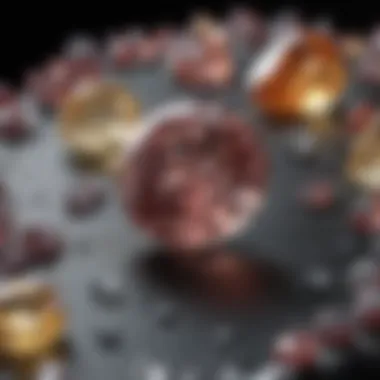

Long-term market trends for diamonds indicate a complex landscape influenced by economic stability, consumer preferences, and even technological advancements. Historically, diamonds have demonstrated an ability to withstand economic downturns better than many other luxury goods. However, the market is not immune to fluctuations.
Recent trends show a growing interest in ethically sourced diamonds, with consumers increasingly placing value on the origin of their purchases. This shift has implications for the market price and overall desirability. Additionally, synthetic diamonds are rising in popularity. Their availability might affect the pricing of natural diamonds, including larger sizes like 5.8 carats.
Investors should also be aware of the impact of global economic conditions. Factors such as inflation, exchange rates, and local market demands can alter investment viability. A diversified approach, considering various segments of the diamond market, is advisable for those looking to invest long-term.
In summary, understanding these investment considerations can assist buyers in making informed decisions about purchasing 5.8 carat diamonds, ensuring potential value growth in an evolving market.
Comparative Pricing Analysis
Comparative pricing analysis is vital in understanding how various factors influence the market value of 5.8 carat diamonds. This method equips buyers with the necessary context to make informed decisions. It creates an opportunity to evaluate diamonds not only in isolation but also alongside similar weights. By assessing price ranges between 5.0 and 6.0 carat diamonds, consumers can recognize trends and differences due to slight variations in size and quality.
A clear understanding of comparative pricing aids in identifying fair market value. It allows potential buyers to benchmark against their budget without overpaying. As values fluctuate with market demand and availability, comparative analysis highlights what constitutes a reasonable offer based on multiple sources and locations.
Price Ranges for 5. to 6. Carat Diamonds
The price range for 5.0 to 6.0 carat diamonds typically reflects several variables including the quality of the stone as determined by the 4Cs. For instance, a 5.0 carat diamond may range from $30,000 to $50,000. In contrast, a 6.0 carat diamond can go from $60,000 to upwards of $100,000. Such substantial differences often arise from factors like cut, color, and clarity.
It is important to note that when discussing price ranges, buyers should source data from reputable gemological institutes and retailers. This ensures that the comparison remains anchored to authentic valuations. Additionally, as diamonds near the 6.0 carat mark, the jump in price tends to be more pronounced, indicating the presence of higher demand for larger stones.
- Quality Impact: Higher quality diamonds, even at a lower carat, might sell for more than lower quality larger stones.
- Market Dynamics: Understanding economic trends can shift these ranges over time, emphasizing the need for continuous research in diamond pricing.
Location and Regional Differences
Pricing also varies greatly based on location. In metropolitan areas, such as New York or Los Angeles, consumers might find higher prices due to increased overhead costs and market demand. Conversely, in smaller towns or countries with a lower cost of living, prices can be significantly reduced.
Moreover, certain regions may have higher concentrations of luxury retailers. This creates competitive pricing structures that can either inflate or deflate market values. For instance, Dubai, known for its diamond trade, might offer lower prices than European counterparts due to less tax burdens and regulations.
- Regional Supply Chains: Shipping costs and local jewelry taxes can contribute to price differences.
- Cultural Values: In some cultures, diamonds are predominantly associated with status, leading to higher prices.
- Market Saturation: Areas with numerous jewelers may encourage competitive pricing, benefiting savvy buyers.
"Understanding pricing allows investors and buyers alike to navigate the diamond market intelligently, ensuring maximum value and satisfaction."
Ultimately, comparative pricing analysis serves as an essential tool for any prospective diamond buyer. It fosters greater awareness of the nuances in the market, equipping consumers to make wise choices as they consider a 5.8 carat diamond.
Epilogue
The conclusion serves to synthesize the comprehensive information presented earlier in the article. Here, the final reflections on the pricing of 5.8 carat diamonds are made, emphasizing the interconnectedness of various factors involved in diamond valuation. Understanding how these elements work together is crucial for anyone engaging in the diamond market.
The Interplay of Factors in Diamond Valuation
The pricing of a 5.8 carat diamond does not rest solely on its carat weight. Several aspects play a significant role in determining its value. The four Cs—cut, color, clarity, and carat weight—are foundational. Each aspect contributes to the overall aesthetic and desirability of the stone.
- Cut: This evaluates how well the diamond has been shaped and polished. A superior cut enhances brilliance and fire, which often leads to a higher price.
- Color: The less color a diamond possesses, the more valuable it generally is. For 5.8 carat diamonds, the color grade can notably affect the price.
- Clarity: This reflects the presence of internal or external flaws. Higher clarity results in a more valuable diamond.
- Carat Weight: While this section focuses on 5.8 carats, it’s important to note that weight significantly increases the cost as size grows.
Beyond the 4Cs, market conditions also matter. Demand fluctuations can alter prices. Knowledge of these dynamics is essential for potential buyers and sellers in the marketplace.
"Understanding diamond pricing is not merely an exercise in valuation; it influences investment decisions and buyer satisfaction."
Final Thoughts on Purchasing
When considering the purchase of a 5.8 carat diamond, buyers should weigh all aspects discussed. Ensure that you understand the certification of the diamond. Certificates from recognized bodies like GIA, AGS, or EGL provide credibility and assurance of quality. It is also advisable to know the trends in pricing, taking into account both current market conditions and historical data.
Moreover, ethical sourcing should be part of the purchasing strategy. Opting for conflict-free diamonds strengthens market integrity and personal satisfaction with the purchase.
In summary, being informed about the factors that influence pricing not only aids in making sound investment choices but also enhances the overall experience of selecting a diamond. Buyers can approach their transactions with confidence and clarity, ultimately leading to better satisfaction with their choices.

